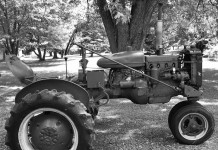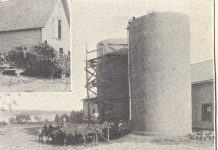As everybody knows, there were many, many manufacturers who tried their hand at building tractors back when the world was young.
Most of these didn’t last long; their early demise was caused by competition, poor design, lack of reliability, high cost, lack of working capital or bad economic times.
Republic
Many of the early automobile and truck manufacturers saw farm tractors as a logical product for their factories and one of these was the Republic Truck Company of Alma, Michigan. The first 3/4 and I-ton Republic trucks were made in about 1912 by the Alma Motor Truck Company, which changed its name to Republic in 1914.
Starting in 1917, Republic had expanded their line to include heavier models and, by 1918, was turning out some 10,000 trucks per year, making them the largest truck builder in the country.
Many of the trucks shipped to the U.S. Army.
Republic was run by Frank W. Ruggles and Channing W. Parsons and these men decided before the war to put out a farm tractor.
Development work seems to have started in May, 1916, when Waukesha supplied a BU4 engine to the firm. Parsons was issued a patent for a tractor frame that had the drawbar cushioned by a large coil spring from the rear end of a longitudinal draft bar mounted under the center of the frame, while the wishbone to the front axle was pivoted to the forward end of the draft bar.
While the patent makes no such claim, it appears this would have helped to prevent the tractor from rearing up in front.
R & P
Ruggles and Parsons organized the R & P Tractor Company to manufacture and sell the tractor, although it was actually built on the same assembly line as Republic trucks.
The R & P Tractor was a trim and, for the time, modem looking machine with rear fenders and a louvered hood. It was powered by a Waukesha 4-cylinder, 3 3/4 inch bore by 5 1/4 inch stroke engine, and was rated at 12 drawbar and 20 belt horsepower.
The vehicle’s weight was 3,600 pounds and the R & P had a 3-speed, truck-type transmission.
One account gives the price of the machine as $1,485, while another quotes it as being $1,365; maybe both are correct — at different times.
Rear wheels
The outstanding feature of the R & P were the rear wheels, which R & P called “Track Laying Double Traction Wheels,” and claimed the “(w)heel makes its own road bed and lays a broad, solid iron track on which the wheels roll. … the sure footed track sections are held against the steel wheel tires by means of springs which ensure the wheels run smoothly over the tracks. The wheel places the track section on the ground, the heavy channel lugs being forced into the ground by the weight of the wheel … After the wheel has passed over a track section, it is lifted by the coil spring. The R & P Wheel is simplicity itself and eliminates expensive upkeep.”
One account says the wheels were developed in Italy during World War One for their army’s artillery tractors, while another tells us the wheels were designed by Republic “for hauling big guns through the mud of Passchendaele in the First World War.”
The wheels were called Craig patent wheels, and the Craig Tractor Company made the 15-25 Craig tractor in Cleveland, Ohio, from 1919 to 1921, using the same wheels on its tractors.
Therefore it seems likely that the inventor’s name was Craig, hardly an Italian name, although I haven’t yet found the patent.
It appears the wheels may have worked too well, since the lack of wheel slip put excessive strain on the differential, which was a modified version of the same rear ends used in Republic trucks.
Problem
One story is told about an R & P owner who, after replacing the differential gears several times, became so disgusted that he removed low gear from the transmission and used the tractor for light work only.
Operator platform
The operator’s platform of the R & P tractor is wide and roomy, mostly because there are hardly any controls to clutter up the space. A steel pan seat on a curved spring mounting shares the space with a foot clutch pedal coming out of the floor, while the steering post goes through the floor at the very front next to the firewall.
A hand throttle lever is on a quadrant just beneath the fat, wood-rimmed steering wheel; the gear shift lever comes out of the center of the firewall and there are two small round buttons or knobs beside that.
There is no brake of any kind, a common feature of tractors at the time.
R & P (sometimes called Republic) tractors were made from 1918 to 1920, although in small quantities; one former employee remembered that usually just one machine a week was built, although occasionally production doubled or tripled to two or three per week.
Manufactured
It is believed that only about 200 R & P tractors were built before production ceased in 1920, apparently about the same time that Frank Ruggles left the firm and moved to Saginaw, Michigan, where he built Ruggles trucks and busses until that firm went under in 1928.
Republic continued to build trucks in Alma and, although on a shaky financial footing, bought the Linn Manufacturing Company, builders of heavy, half-track trucks, in 1928.
Republic merged with another financially embarrassed truck company, American Lafrance in 1929, just in time for the Great Depression, and Lafrance-Republic made conventional and fire trucks until being bought by Sterling Motor Truck Company in 1932.












